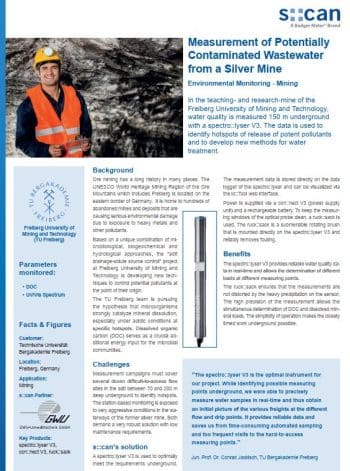In the teaching- and research-mine of the Freiberg University of Mining and Technology(Opens in a new tab or window), water quality is measured 150 m underground with a spectro::lyser V3. The data is used to identify hotspots of release of potent pollutants and to develop new methods for water treatment.
Measurement of Potentially Contaminated Wastewater from a Silver Mine
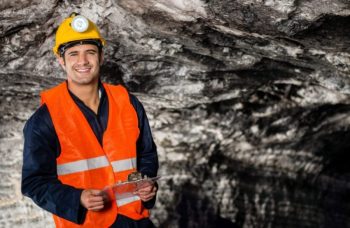
Background
Background
Ore mining has a long history in many places. The UNESCO World Heritage Mining Region of the Ore Mountains which includes Freiberg is located on the eastern border of Germany. It is home to hundreds of abandoned mines and deposits that are causing serious environmental damage due to exposure to heavy metals and other pollutants.
Based on a unique combination of microbiological, biogeochemical and hydrological approaches, the “adit drainage-solute source control” project at Freiberg University of Mining and Technology is developing new techniques to control potential pollutants at the point of their origin.
The TU Freiberg team is pursuing the hypothesis that microorganisms strongly catalyze mineral dissolution, especially under acidic conditions at specifc hotspots. Dissolved organic carbon (DOC) serves as a crucial additional energy input for the microbial communities.
Challenges
Measurement campaigns must cover several dozen difficult-to-access flow sites in the adit between 70 and 200 m deep underground to identify hotspots. The station-based monitoring is exposed to very aggressive conditions in the waterways of the former silver mine. Both demand a very robust solution with low maintenance requirements.
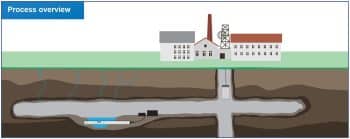
s::can’s solution
A spectro::lyser V3 is used to optimally meet the requirements underground. The measurement data is stored directly on the data logger of the spectro::lyser and can be visualized via the Io::Tool web interface. Power is supplied via a con::nect V3 (power supply unit) and a rechargeable battery. To keep the measuring windows of the optical probe clean, a ruck::sack is used. The ruck::sack is a submersible rotating brush that is mounted directly on the spectro::lyser V3 and reliably removes fouling.
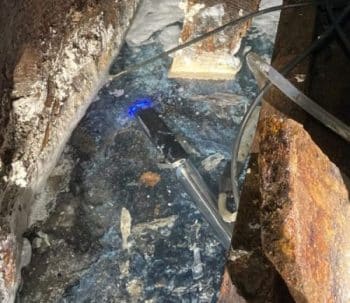
Benefits
The spectro::lyser V3 provides reliable water quality data in real-time and allows the determination of different loads at different measuring points. The ruck::sack ensures that the measurements are not distorted by the heavy precipitation on the sensor. The high precision of the measurement allows the simultaneous determination of DOC and dissolved mineral loads. The simplicity of operation makes the closely timed work underground possible.
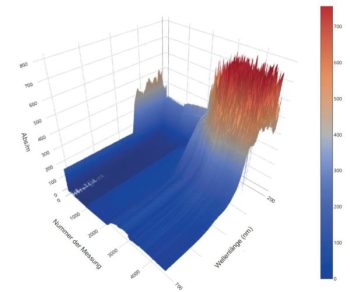
spectro::lyser „Reiche Zeche“ – 3D Spectrum
The figure shows the absorption spectrum measured with the spectro::lyser over time, for different series of measurements. High absorbance values in the wavelength range from around 250 to 350 nm indicate increased DOC concentrations.
“The spectro::lyser V3 is the optimal instrument for our project. While identifying possible measuring points underground, we were able to precisely measure water samples in real-time and thus obtain an initial picture of the various freights at the different flow and drip points. It provides reliable data and saves us from time-consuming automated sampling and too frequent visits to the hard-to-access measuring points.”
– Jun. Prof. Dr. Conrad Jackisch, TU Bergakademie Freiberg
